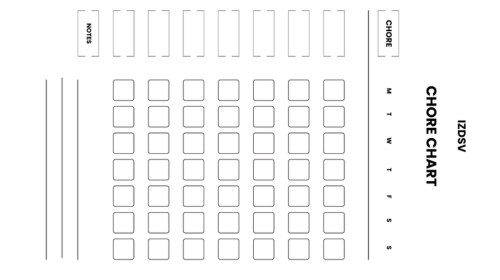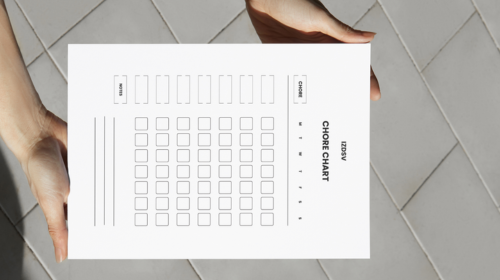Family Chore Chart: Printable and Digital Chore Chart Template
Benefits of Using a Printable and Digital Chore Chart
A chore chart provides clear visual accountability that helps family members understand their responsibilities and track completion of tasks. Both printable and digital formats offer flexibility to match different household preferences and technological comfort levels.
- Establishes routine and structure – Children thrive on predictability, and a visible chart creates consistent expectations for daily and weekly tasks
- Teaches responsibility and time management – Kids learn to plan their day around obligations and experience the satisfaction of completing commitments
- Reduces nagging and conflicts – Parents can simply point to the chart instead of repeatedly reminding children, making expectations objective rather than personal
- Builds life skills – Regular chores teach practical abilities like cleaning, organizing, and maintaining a household that children will need as adults
- Provides a sense of accomplishment – Checking off completed tasks gives children tangible evidence of their contributions and boosts self-esteem
- Encourages teamwork – A family chart shows everyone’s role in maintaining the household, fostering a collaborative spirit
- Flexibility in format – Printable versions work for families who prefer tangible, posted reminders, while digital charts suit tech-savvy households with mobile access
- Easy customization – Both formats can be adjusted weekly or monthly to match changing schedules, ages, and family needs
Encouraging Kids to Help with Simple Chores
Making chores age-appropriate and fun transforms household tasks from burdens into opportunities for children to feel capable and valued. Positive reinforcement and creative approaches work far better than force or punishment when building lasting habits.
- Start early with simple tasks – Even toddlers can put toys in bins or help sort laundry, building the foundation that helping is normal
- Match chores to abilities – Three-year-olds can dust low surfaces while ten-year-olds can load dishwashers, ensuring tasks feel achievable, not frustrating
- Use gamification – Turn cleaning into races, play upbeat music during chore time, or create point systems that make tasks feel playful
- Offer meaningful choices – Let children pick between two chores or decide the order they complete tasks, giving them autonomy and buy-in
- Work alongside them initially – Demonstrate techniques and make it a social time rather than isolating children with tasks they may not fully understand
- Celebrate effort over perfection – Praise their willingness to help and improvement over time, rather than criticizing imperfect results
- Connect to privileges – Link completed chores to screen time, playdates, or allowance so children understand contribution comes before rewards
- Use visual timers – Help children understand how long tasks take and create friendly competition to beat previous times
- Rotate responsibilities – Prevent boredom and resentment by switching up who does what, keeping things fresh and fair
Organizing Chores with a Family Command Center
A family command center serves as the household’s central hub where schedules, responsibilities, and important information converge in one accessible location. This dedicated space eliminates the chaos of scattered notes and forgotten tasks by putting everything family members need to see in a single, organized spot.
- Choose a high-traffic location – Place your command center in the kitchen, mudroom, or main hallway where family members naturally pass multiple times daily
- Include a large calendar – Display the month at a glance with color-coded entries for each family member so everyone sees upcoming events and deadlines
- Add a chore chart section – Dedicate space specifically for the weekly or daily chore assignments with check-off boxes or magnets to track completion
- Create inbox/outbox slots – Install folders or trays for school papers, permission slips, bills, and mail so important documents don’t get lost
- Post emergency information – Keep phone numbers, addresses, and basic first aid instructions visible for babysitters and emergencies
- Include a message board – Use a whiteboard or chalkboard for quick notes, grocery lists, and communication between family members
- Add organizational tools – Install hooks for keys, clips for coupons, and pockets for pens so everything has a designated home
- Keep it age-accessible – Position elements at heights where children can reach their sections and independently check responsibilities
- Update weekly – Schedule a consistent time, like Sunday evening, to refresh the calendar and chore assignments for the coming week
- Personalize with family style – Make it inviting with colors, photos, or decorations so family members actually want to engage with it
Designing Your Own Free Printable Chore Chart
Creating a custom chore chart allows you to tailor the design specifically to your family’s unique needs, routines, and visual preferences. A well-designed chart becomes a functional tool that family members actually want to use rather than ignore.
- Determine your layout format – Decide whether you want a daily grid, weekly spread, or monthly overview based on how frequently chores rotate and need tracking
- Select age-appropriate visuals – Use pictures or icons for young children who can’t read yet, while older kids and teens can work with text-based charts
- Choose motivating colors – Bright, cheerful colors engage children, while neutral tones might suit teen or adult-focused charts better
- Include space for names – Designate clear sections for each family member so everyone knows exactly which tasks belong to them
- Add completion indicators – Design boxes for checkmarks, stickers, or stamps that provide satisfying visual confirmation of finished tasks
- Consider laminating options – If you plan to reuse the chart weekly, design it so you can laminate and use dry-erase markers rather than printing repeatedly
- Balance detail with simplicity – Include enough information to be clear, but avoid cluttering the design with excessive text or decorative elements
- Use free design tools – Platforms like Canva, Google Docs, or Microsoft Word offer templates and design elements without requiring graphic design skills
- Test the sizing – Ensure your chart prints clearly on standard letter or A4 paper, or design it specifically for poster size if you want larger visibility
- Make it reflect your family – Add family photos, inside jokes, or personal touches that make the chart feel uniquely yours rather than generic
Choosing the Right Chore Chart Template
The ideal chore chart template matches your family’s size, children’s ages, and the complexity of tasks you need to organize. Selecting the right foundation saves time and increases the likelihood that everyone will consistently use the system.
- Assess your family structure – Large families need multi-column templates, while single-parent or small households can use simpler designs with fewer sections
- Match template to children’s ages – Preschoolers need picture-based charts, elementary kids work well with simple lists, and teens can handle detailed responsibility matrices
- Consider chore frequency – Daily task lists work for routine chores like making beds, while weekly charts suit rotating responsibilities like bathroom cleaning
- Evaluate customization needs – Some templates are fully editable while others are fixed designs, so choose based on whether you’ll want to modify categories and tasks
- Look for reward integration – Templates with built-in point systems, allowance trackers, or goal sections add motivation if your family uses incentive-based systems
- Check printing requirements – Verify the template works with your printer capabilities and doesn’t require special paper, color printing, or unusual dimensions
- Review user feedback – If downloading from template sites, read comments to see if others found it practical and easy to implement
- Test compatibility – Ensure the template opens properly in software you have available, whether that’s PDF readers, Word, Excel, or design programs
- Start simple – When in doubt, choose a straightforward template first and add complexity later rather than overwhelming your family with an elaborate system initially
- Preview before committing – Print a sample or test version to see how it looks in your intended display space before finalizing your choice
Incorporating Checklist Features for Efficiency
Checklist features transform a basic chore chart into an interactive accountability system that provides clear feedback and progress tracking. These elements make completing tasks more satisfying and help parents monitor follow-through without constant supervision.
- Design clear checkbox spaces – Make boxes large enough for checkmarks, stickers, or stamps so even young children can easily mark completion without frustration
- Use different completion indicators – Implement checkmarks for done, X’s for skipped, or stars for exceptionally well-done tasks to provide nuanced feedback
- Add time-of-day sections – Separate morning, afternoon, and evening chores so children understand when tasks should be completed, not just that they need doing
- Include quality checkpoints – Add secondary boxes for parent verification or inspection to ensure tasks meet standards, teaching accountability beyond just completion
- Create streak trackers – Design sections that highlight consecutive days of completion to motivate consistency and celebrate sustained effort
- Build in weekly reset points – Include clear start-of-week dates or spaces that show when the chart refreshes, preventing confusion about old versus current responsibilities
- Add note sections – Provide small spaces for comments about challenges, task swaps, or adjustments needed for the following week
- Use color-coding systems – Assign different colored checkboxes or sections to various family members or task categories for quick visual scanning
- Incorporate progress bars – Include fillable sections that show weekly or monthly completion percentages to gamify the experience and visualize success
- Design for multiple checking methods – Make the chart compatible with physical markers, stickers, or even digital photos of completion if using a hybrid approach
Best Ideas for Printable and Digital Chore Charts for Kids
The most effective chore charts capture children’s attention through creative designs while maintaining functionality that makes tracking simple for busy parents. Combining visual appeal with practical features ensures the chart becomes a useful tool rather than just decorative wall clutter.
- Theme-based charts – Design charts around your child’s interests, like dinosaurs, space, princesses, sports, or superheroes to increase engagement and ownership
- Reward pathway designs – Create charts that look like board games where children move a marker along a path toward a prize as they complete tasks
- Magnetic chore systems – Use printable magnets or magnetic boards where kids physically move chore tiles from “to-do” to “done” columns for tactile satisfaction
- Spinner wheel charts – Design rotating wheels where children spin to randomly select their chore, adding an element of surprise and fairness
- Level-up progression charts – Create video game-inspired designs where completing chores earns experience points and unlocks new levels or privileges
- Before and after charts – Use simple two-column formats showing morning routines and evening tasks, perfect for younger children learning daily structure
- Allowance integration charts – Include money-tracking features where each chore has an associated value, teaching financial responsibility alongside household contribution
- Digital app-based systems – Utilize free apps like OurHome, ChoreMonster, or Homey that send notifications, track completion digitally, and work across multiple devices
- Photo-based charts – Include actual photos of the completed task (like a made bed or organized toy shelf) so children know exactly what the standard looks like
- Team challenge charts – Design collaborative charts where siblings work together toward family goals, building cooperation rather than competition
- Seasonal rotation charts – Create charts that change with seasons, adding outdoor chores in summer and different indoor tasks during winter months
- Habit stacking charts – Link chores to existing routines (after breakfast, before screen time) so tasks become automatic parts of daily flow
Creating Engaging Chore Lists
Chore lists become engaging when they speak to children’s developmental stages and incorporate elements of fun, choice, and achievement. The difference between a list kids ignore and one they actually use often comes down to presentation and psychological motivation techniques.
- Use action-oriented language – Write “Feed our hungry pets” instead of “Feed dog” or “Be a dish hero” instead of “Load dishwasher” to make tasks sound adventurous
- Break tasks into micro-steps – For younger children, list “Pick up toys,” “Put books on shelf,” and “Place dirty clothes in hamper” separately rather than just “Clean room”
- Add completion time estimates – Include “5 minutes” or “10 minutes” next to tasks so children understand the commitment and can better manage their time
- Incorporate choice within structure – Offer “Pick 3 chores from this list” or “Choose morning OR evening dish duty” to give autonomy while maintaining expectations
- Create category groupings – Organize lists by room (bedroom chores, kitchen chores) or type (animal care, cleaning, organizing) for logical flow
- Use positive framing – Write “Help family by setting the table” rather than “You must set the table” to emphasize contribution over obligation
- Include occasional special tasks – Add fun or unusual chores periodically, like “Help bake cookies” or “Wash the car with dad” to break monotony
- Design progressive difficulty levels – Label tasks as beginner, intermediate, or advanced so children can challenge themselves as skills improve
- Add personal responsibility items – Include self-care tasks like “Brush teeth” or “Pack backpack” alongside household chores to build comprehensive life skills
- Build in flex options – Allow task swaps between siblings or substitutions when someone is sick or overwhelmed with schoolwork
- Use visual task cards – Create individual cards for each chore that children can arrange, organize, and check off for hands-on interaction
- Celebrate milestone completions – Mark special achievements on the list itself, like “10th time vacuuming!” or “One month of bed-making!”
Using Dry Erase Boards for Chore Management
Dry erase boards offer unmatched flexibility for families whose schedules and needs change frequently, eliminating waste from constant reprinting. The erasable, rewritable nature makes adjustments easy while the physical presence creates a visible reminder that stays top-of-mind.
- Choose the right board size – Large boards work well in high-traffic areas like kitchens, while smaller individual boards can hang in children’s bedrooms for personal task lists
- Create permanent grid structures – Use permanent markers or vinyl decals to establish rows and columns that won’t erase, then fill in tasks and names with dry erase markers
- Implement color-coded systems – Assign each family member a specific marker color so everyone can quickly identify their responsibilities at a glance
- Add magnetic functionality – Use magnetic dry-erase boards with small magnets as checkmarks that children physically move when tasks are complete
- Design weekly sections – Divide the board into seven columns for each day, allowing you to plan different chores throughout the week
- Include a legend or key – Create a permanent section explaining symbols, abbreviations, or codes used on the board for clarity
- Use erasable task strips – Apply lines of painter’s tape to create rows that can be relabeled as needed without disturbing the overall structure
- Incorporate goal-setting space – Reserve a section for weekly family goals or individual achievement targets that complement daily chores
- Add an encouragement zone – Include space for motivational messages, jokes, or positive notes that parents can write to children
- Keep cleaning supplies nearby – Store markers, erasers, and cleaning spray in an attached caddy, so maintaining the board doesn’t become another chore
- Take weekly photos – Photograph the board before erasing to track what worked well and reference past arrangements when planning future weeks
- Create morning and evening divisions – Split the board horizontally to separate AM routines from PM tasks for better time-of-day organization
- Use dot voting for task assignment – Let family members place erasable dots next to preferred chores during weekly planning meetings for democratic distribution
How to Implement a Chore System in Your Family
Successfully implementing a chore system requires thoughtful planning, clear communication, and a gradual rollout that allows family members to adjust to new expectations. The key is starting with realistic goals and building momentum through early wins rather than overwhelming everyone with an overly ambitious system from day one.
- Hold a family meeting – Gather everyone to explain why chores matter, discuss household needs, and get buy-in from all family members before launching the system
- Start with a trial period – Implement a two-week test run where everyone understands adjustments will be made, reducing resistance and allowing for feedback-based improvements
- Assign age-appropriate tasks – Match chores to developmental abilities so toddlers handle simple tidying while teens manage complex tasks like meal preparation or laundry
- Be specific about expectations – Define exactly what “clean the bathroom” means with clear standards rather than leaving children guessing what constitutes completion
- Create visual reminders – Post the chore system prominently where family naturally gathers, so it becomes part of the household landscape
- Establish consequences and rewards – Determine upfront what happens when chores are completed or skipped, whether that’s allowance, screen time, or other privileges
- Lead by example – Ensure parents visibly do their own chores and household tasks to demonstrate that everyone contributes regardless of age
- Schedule a weekly review – Set aside 10-15 minutes each week to discuss what’s working, address challenges, and make necessary adjustments
- Address resistance calmly – Expect pushback initially and respond with consistency rather than anger, reinforcing that chores are non-negotiable parts of family life
- Rotate responsibilities periodically – Switch chores every month or quarter to prevent boredom, teach diverse skills, and maintain fairness
- Document the system – Write down or print the chore assignments, rules, and expectations so everyone can reference them when questions arise
- Involve kids in planning – Let children have input on which chores they prefer, when they complete them, and how the system operates to increase ownership
Setting Up a Routine for Chores Done
A well-structured routine transforms sporadic chore completion into automatic habits by anchoring tasks to specific times and existing daily rhythms. Consistency in timing helps children internalize responsibilities until completing chores feels as natural as brushing teeth.
- Anchor to existing routines – Link chores to established activities like “after breakfast” or “before screen time” so they become natural extensions of what kids already do
- Create time blocks – Designate specific windows like “chore time is 4-5 pm on weekdays” so children can plan their day and know when tasks are expected
- Use timers and alarms – Set phone or device reminders that signal chore time, removing the burden of parental nagging and making the schedule feel objective
- Establish a consistent sequence – Have children complete chores in the same order each day (make bed, then feed pet, then take out trash) to build automatic patterns
- Build in buffer time – Allow reasonable completion windows rather than rigid deadlines to accommodate homework, activities, and unexpected schedule changes
- Create morning and evening routines – Separate lighter morning tasks (making bed, putting away pajamas) from more involved evening chores (dishes, tidying common areas)
- Use transition rituals – Develop signals that mark chore time beginning, like playing a specific song or ringing a bell, creating a mental shift
- Plan around family schedule – Align chore timing with when energy is highest and schedules are least rushed, avoiding homework hours or right before bedtime
- Include completion checkpoints – Establish specific moments when parents inspect or verify finished chores, like before dinner or bedtime, creating accountability
- Make weekends different – Designate deeper cleaning or special projects for weekends when there’s more time and less school-related stress
- Post the schedule visibly – Display the routine timeline where everyone can see it, eliminating confusion about when tasks should happen
- Practice the routine initially – Walk through the schedule together for the first week, physically doing chores at designated times to establish the pattern
- Allow natural consequences – If chores aren’t done during the designated time, the window closes, and associated privileges are delayed until completion
Encouraging Participation
Sustained participation in chores requires more than just establishing a system—it demands ongoing motivation, recognition, and adjustments that keep children engaged over time. The most successful families treat chore participation as a developing skill that needs nurturing rather than an automatic behavior they can demand.
- Celebrate small wins consistently – Acknowledge effort and completion immediately with verbal praise, high-fives, or simple recognition to reinforce positive behavior
- Use specific praise – Say “I noticed you organized the dishes by size—that makes unloading so much easier” rather than generic “good job” to show genuine attention
- Implement a points or token system – Create tangible rewards where completed chores earn points toward privileges, treats, or special activities
- Offer age-appropriate incentives – Young children respond to sticker charts and small toys, while teens might prefer money, extended curfews, or technology privileges
- Create healthy competition – Occasionally host family challenges like “who can fold laundry fastest” or “neatest room award” to make chores playful
- Work alongside them sometimes – Join children during chore time periodically, making it social bonding rather than isolated drudgery
- Connect chores to values – Help children understand how their contributions matter by explaining “Your help gives me time to play with you” or “We can afford fun activities when we save money”
- Give increasing responsibility – Gradually expand trusted children’s roles with more complex or important tasks, showing confidence in their growing capabilities
- Avoid redoing their work – Resist the urge to perfect children’s efforts immediately afterward, as this undermines their sense of accomplishment and competence
- Share household wins – When the house looks great or a big project is completed, celebrate as a family and acknowledge everyone’s role in the success
- Listen to feedback – Take complaints seriously and problem-solve together about tasks that feel unfair, too difficult, or poorly timed
- Model positive attitude – Demonstrate that adults also complete unpleasant tasks without excessive complaining, showing that responsibility is part of life
- Adjust for individual needs – Recognize that some children need more reminders, prefer certain tasks, or work better at different times, and accommodate reasonable differences
- Make completion visible – Use charts, apps, or other tracking methods that let children see their progress accumulate over weeks and months
- Periodically refresh the system – Introduce new elements, change reward structures, or redesign charts every few months to prevent staleness and maintain interest




